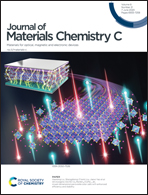Color tuning of dibenzo[a,c]phenazine-2,7-dicarbonitrile-derived thermally activated delayed fluorescence emitters from yellow to deep-red†
Abstract
A molecular design approach for synthesizing color-tunable and high-efficiency TADF emitters in the long-wavelength region was developed. The synthesis involves the direct attachment of three different electron-donating groups, namely 3,6-di-tert-butylcarbazole (tCz), 9,9-dimethyl-9,10-dihydroacridine (Ac), and N3,N3,N6,N6-tetraphenyl-9H-carbazole-3,6-diamine (DACz), to the highly rigid dibenzo[a,c]phenazine-2,7-dicarbonitrile (BPCN) acceptor unit. Among them, the highly distorted donor–acceptor-based Ac-BPCN emitter exhibited a high EQE of above 20% with color coordinates of (0.54, 0.45) and a peak wavelength of 597 nm. Highly red-shifted emission of up to 631 nm with color coordinates of (0.60, 0.39) was enabled by the DACz-BPCN emitter due to the strong donor character of DACz. The emission wavelengths of the three TADF emitters cover a wide range of the long-wavelength region of the visible spectrum, from yellow (548 nm) to deep-red (631 nm). The peripheral cyano-substituted rigid BPCN unit proved its potential as an efficient electron acceptor for the design of highly efficient and long-wavelength TADF emitters.
![Graphical abstract: Color tuning of dibenzo[a,c]phenazine-2,7-dicarbonitrile-derived thermally activated delayed fluorescence emitters from yellow to deep-red](/en/Image/Get?imageInfo.ImageType=GA&imageInfo.ImageIdentifier.ManuscriptID=D0TC00960A&imageInfo.ImageIdentifier.Year=2020)


 Please wait while we load your content...
Please wait while we load your content...